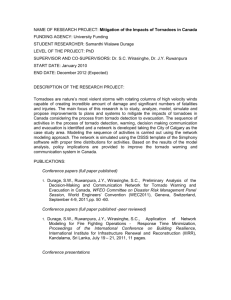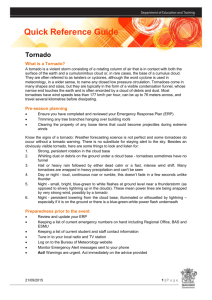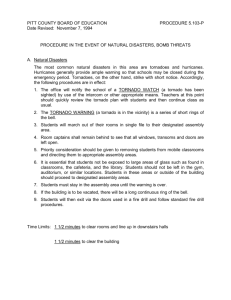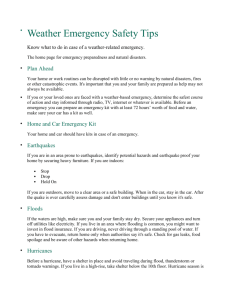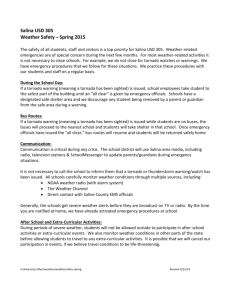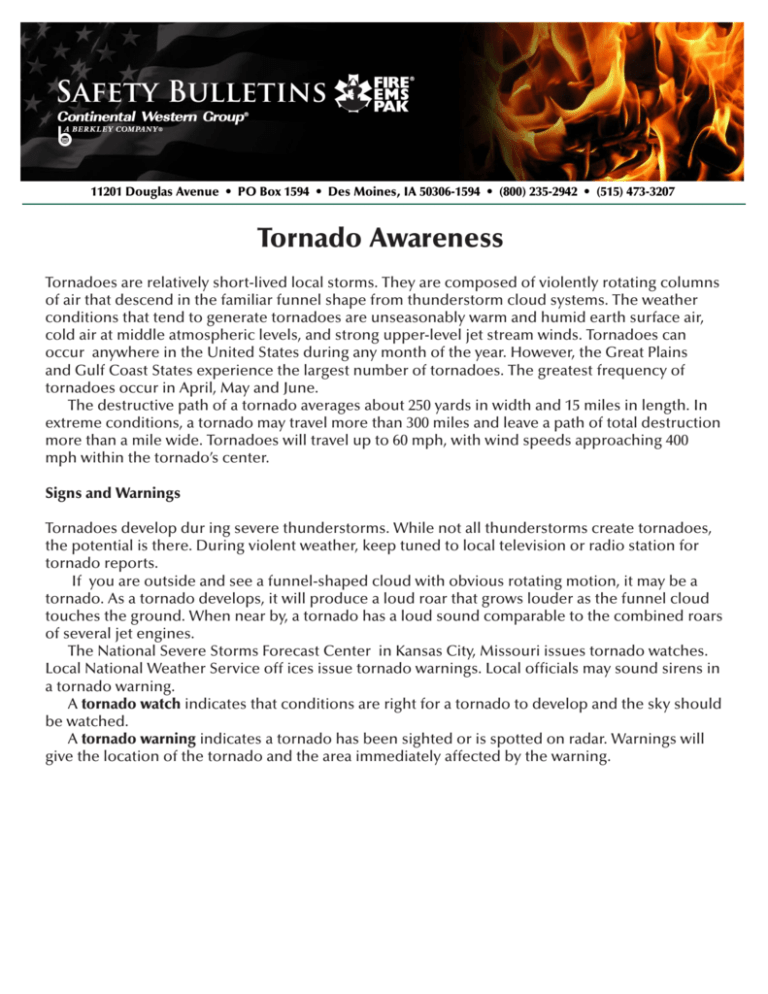
11201 Douglas Avenue • PO Box 1594 • Des Moines, IA 50306-1594 • (800) 235-2942 • (515) 473-3207
Tornado Awareness
Tornadoes are relatively short-lived local storms. They are composed of violently rotating columns
of air that descend in the familiar funnel shape from thunderstorm cloud systems. The weather
conditions that tend to generate tornadoes are unseasonably warm and humid earth surface air,
cold air at middle atmospheric levels, and strong upper-level jet stream winds. Tornadoes can
occur anywhere in the United States during any month of the year. However, the Great Plains
and Gulf Coast States experience the largest number of tornadoes. The greatest frequency of
tornadoes occur in April, May and June.
The destructive path of a tornado averages about 250 yards in width and 15 miles in length. In
extreme conditions, a tornado may travel more than 300 miles and leave a path of total destruction
more than a mile wide. Tornadoes will travel up to 60 mph, with wind speeds approaching 400
mph within the tornado’s center.
Signs and Warnings
Tornadoes develop dur ing severe thunderstorms. While not all thunderstorms create tornadoes,
the potential is there. During violent weather, keep tuned to local television or radio station for
tornado reports.
If you are outside and see a funnel-shaped cloud with obvious rotating motion, it may be a
tornado. As a tornado develops, it will produce a loud roar that grows louder as the funnel cloud
touches the ground. When near by, a tornado has a loud sound comparable to the combined roars
of several jet engines.
The National Severe Storms Forecast Center in Kansas City, Missouri issues tornado watches.
Local National Weather Service off ices issue tornado warnings. Local officials may sound sirens in
a tornado warning.
A tornado watch indicates that conditions are right for a tornado to develop and the sky should
be watched.
A tornado warning indicates a tornado has been sighted or is spotted on radar. Warnings will
give the location of the tornado and the area immediately affected by the warning.
Immediate Dangers
The immediate threat from tornadoes is danger to life and damage to property from violently
whirling winds and debris hurled through the air by winds.
Long Term Dangers
Long-term risks include the possibility of building collapse, fallen trees and power lines, broken
gas lines, broken sewer and water mains, and the outbreak of fires. Agricultural crops and
industries may be damaged or destroyed.
Preparedness
The best preparation for a tornado is to designate a safe place in or around your home as a
tornado shelter. Tornado shelters are safest if they are under ground. A storm cellar or basement
away from windows offers the best protection.
Continental Western Group® and affiliated companies assume no liability in connection with your use or non-use of the information provided in this document
and do not guarantee that the information contained herein includes all possible risks or unusual circumstances that may occur in or to your business or that the
advice or recommendations contained herein comply with all federal, state or local laws or regulations. Any advice or recommendations made in this document
are intended to assist you in reducing risk of loss, thereby reducing the possibility that our companies will need to make a payment under an insurance policy.
These recommendations are not intended to substitute for any obligation that you or anyone else may have to survey, repair, or modify any property, equipment
or operations or to conduct safety programs. It is your legal responsibility to maintain safe premises, equipment and operations. This document provides general
information only, is not legal advice, and is not a statement of contract. Any statement regarding insurance coverage made herein is subject to all provisions and
exclusions of the entire insurance policy.
Copyright © 2013 Continental Western Group®. All rights reserved.

